Abstract
To optimize anthropogenic material streams, the production process, as well as the quality of the products, must be known. With knowledge of these requirements, it is possible to use extra applied algorithms—in this case evolutionary algorithms as part of artificial intelligence—for the optimization of these secondary material streams. The benefit of this application is the fast and precise calculation of the local and global optima of the optimizing problem. This calculation method uses the benefits of the biological reproduction by applications of mutation, selection, and recombination to find one of the best results in a huge amount of possible and potential results. For the use of secondary materials in the paper production it could be proven that in spite of high quotes of secondary materials in different paper classes, there are some paper classes in which the amount of secondary material could be raised without losing any quality.
The aim of zero waste is a good goal for the future, but we have to accept that an affluent society will always produce natural and anthropogenically created waste.
There are “three Rs”—Reduce, Re-use, and Recycle that are always mentioned and important, and with these the hierarchy of waste minimization is explained. But what should be done with waste without the use of recycling?
In this case, the recycling itself has to be optimized to process the largest possible amount of waste products in the production process of new materials. This optimization allows a minimization of primary raw material and additionally a minimization of waste. Because of the use of more short-lived products, the affluent society always requires more resources to fulfill the need of the required materials. Because of such consumption, nature has too little time for recovery and regeneration. The use of secondary materials as a substitute resource can, for the most part, cover the bulk of the resource requirement while preventing overexploitation of the natural primary resources at the same time. The sixth German Environmental Program from the Federal Ministry of Environment and Conservation clearly pointed towards improved resource utilization efficiency and minimization of the negative impact on the environment by the usage of available resources (BMU, Citation2006).
Fundamental to the argument for the effective use of secondary materials is an understanding of the product circle and the numerical calculation of the resource input. The boundaries of the production process and the qualities and quantities of the materials are also related.
All these factors have to be considered in the calculation and have different impacts on the production process and the final product itself. Because of the great variability of mutually dependent parameters in the calculation, most of the common numerical calculation methods reach their limits (Pollmann, Citation2007). As the main calculation module for the problem of optimization, evolutionary algorithms were used as a component of artificial intelligence. With these algorithms acting like the model of evolution, the input of secondary materials for the production of products with similar quality was optimized.
Using paper production as an example, it could be proved by utilizing evolutionary algorithms that by raising the input of secondary materials (waste papers), the quality of the final product need not be compromised. This result makes it possible to implement the substitution of primary materials in the paper production process by means of a more efficient use of existing resources.
MATERIALS AND METHODS
Indicator Carbon
In order to optimize the use of secondary materials in paper production, the process itself was investigated (Figure ) and reduced to the lowest common indicator—in this case carbon.
FIGURE 1 Production processes for paper production (Pollmann, Citation2007).
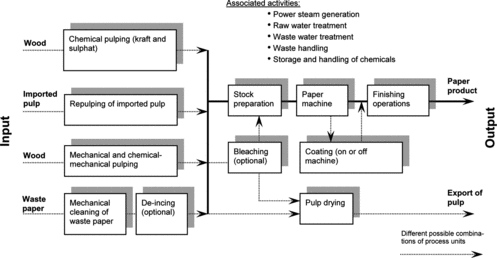
This indicator is an element that cannot be reduced any further (Baccini and Bader, Citation1996). Related to different products, all proportions of carbon are calculated relative to the mass and balanced for each production step. This balance makes it possible to finally compare all carbon fluxes to prove that the results from the optimization by fiber quality are comparable to the results from the carbon fluxes. Additionally, other allowances for optimizations of the resource input can be visualized.
Indicator Fiber Length
Quality, availability, and reusability are always related to the length of the fibers of the material. This indicator is also used for the calculation and optimization with the evolutionary algorithms. The quality of the paper produced is understandably linked to the fraction of included secondary material. The higher the percentage of secondary material included, the shorter the average length of the fibers in the paper and consequently a less desirable resultant quality (Figure ). To produce a paper of high quality, the carbon fluxes are related to the classes of waste paper and fresh paper to display the material fluxes. With these input values, the evolutionary algorithms can optimize and demonstrate the material flux related to the product quality. With this data, it is possible to raise the percentage of secondary materials in almost all paper classes without loss of quality.
FIGURE 2 Allocation of fiber length and percentage of secondary material for different paper classes (Erhard, Citation2006).
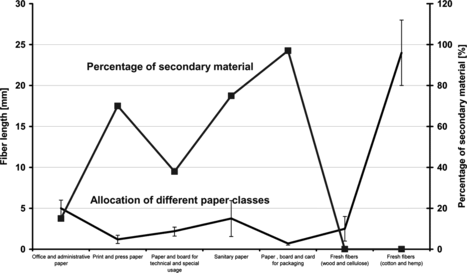
Environmental Factor (UWF)
To inspect the influence of the chosen material mix on the ecology and economy, a cost-related factor (UWF) was implemented. This environmental factor (UWF) is a cost-related coefficient that explains the influence and impact of secondary material on economic and ecological aspects (Table ). Therefore, this factor has an influence on the use of secondary material of lower quality. Beside the use in paper production, most of the secondary materials have no other use in production (ATV-DVWK, Citation2001). Because of that the waste paper has to be deposited on dumping sides which results in relatively high costs (Bos, Veenstra, Verhoeven, and De Vos, Citation1999). In this case the environmental factor influences the calculation positively because of the reuse of the waste paper. Consequently, because of the use of high quality fibers, the factor will influence the process negatively, because fibers with a high market value were used where fibers of lower quality were banned.
TABLE 1 Costs of Waste Paper and Influence of the Environmental Factors (UWF) (Pollmann, Citation2007)
If the factor increases, the net result will be ecologically worse. Decreasing factors will improve the total result ecologically and by changing the boundaries, the results of the optimization will be improved as well.
This factor has no influence on the optimization process of the evolutionary algorithms itself. It only demonstrates the influence of the results on environmental and monetary issues.
Use of Evolutionary Algorithms for Optimization
The composition of different paper classes requires an algorithm that is able to solve equations with 10 or more unknown factors which are additionally interdependent. With common numerical methods, these calculations are solvable only with long calculation time if at all. Because of this fact, evolutionary algorithms were used as a solver functioning as the biological model of evolution (Gerdes, Klawonn, and Kruse, Citation2004).
The benefit of evolutionary algorithms is the objectives-oriented, fast and precise calculation of local and global optima by consideration of different evolutionary influences (Figure ). To calculate the application of optimizing secondary materials, the following parameters have to be determined: computational accuracy, size of search area, objective function, amount of individuals, amount of generations, impact of mutations, crossover, fitness, selection, and definition of an abort criterion. With these specifications, it is possible to optimize different input materials for the production of paper relative to different quality requirements (Pollmann, Citation2006).
FIGURE 3 Sequence diagram of evolutionary algorithms (Pollmann, Citation2007).
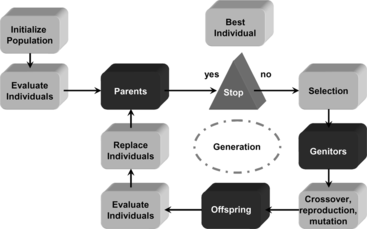
As input materials, all the different secondary and recycled papers, and additionally the primary fibers, are available. From these, the optimized composition related to the fiber length can be calculated. The start vector of the initial population (individuals from the start generation) will be chosen randomly from the mix of input materials.
The principle flowchart (Figure ) was used and implemented for the application of evolutionary algorithms in the paper production. In this regard the following steps were followed:
-
Defining of input and output variables, constants, and functions.
-
Random generation of lists with start populations.
-
Suitability for each list of the population. This implies defining how good the items in the lists comply with the requested task.
-
Executing the selection by fitness function.
-
Executing the gene exchange (crossover, mutation, reproduction), so that correct lists are always generated.
-
Repetition of steps 3 to 5 till the defined abort criterion is achieved.
Important for the flow is that mutation and crossover should be used at the same time to eliminate the premature convergence, a disadvantage of evolutionary algorithms. Otherwise, an occurrence of local optima or of the same individual as a result of the optimization is possible but undesirable.
The result of the material flux optimization in paper production is a calculated material mix that achieves the desired quality. The evolutionary algorithms calculate randomly, by generating a batch of acceptable results within the restricted boundaries, the best result for the solution of the problem (Figure ). The benefit of calculating a system like this with evolutionary algorithms is the very fast detection of possible restricted global optimum (Y t ) out of the total sum of possible results (ΣX t ).
FIGURE 4 Stray field of potential results (Pollmann, Citation2007).
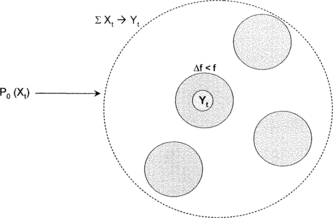
Aim of Optimization: Input of Different Fiber Length
To optimize the input of secondary fibers, the problem was defined and valued by the fiber length of different paper types. The shorter the paper fibers are the poorer the quality of the paper will be. Recycled fiber lengths are shorter because of the processing process. To get a certain average fiber length for a specific paper type by optimization, the quality of the required product must be known. The basis for this optimization is the divided classes of waste papers (Table ) and new papers (Table ) in different quality classes.
TABLE 2 Distribution of Fiber Length and Waste Paper Application Quote of Different Paper Types (see table: from literature)
TABLE 3 Distribution of Fiber Length of Different Materials (see table: from literature)
Because of these quality indicators, an array of different mixtures of secondary materials combined with primary materials for the production of defined paper types can be calculated and optimized by utilizing evolutionary algorithms. Some new fibers will still have to be used because of the fact that these fibers ensure the crucial required quality of the end product.
RESULTS
The optimized material input was calculated (Equation (Equation1)) with three different algorithms: GASteadyStateGA, GACrowdingGA, and GADemeGA as part of artificial intelligence. All calculated values were all in the same range with small insignificant deviations. These deviations in different types of algorithms probably reflect the influence of variable boundary conditions.
As a summed-up result, this optimization demonstrates an improvement for the paper types paper and board for technical and special usage of about 2% (Figure ) and sanitary papers of about 6% (Figure ) with the same end product quality.
FIGURE 5 Results of the material mix from paper and board for technical and special usage (fiber length 1.5–2.7 [mm]) (Pollmann, Citation2007).
![FIGURE 5 Results of the material mix from paper and board for technical and special usage (fiber length 1.5–2.7 [mm]) (Pollmann, Citation2007).](/cms/asset/2598868a-5348-42bd-af60-852bbda8c356/uaai_a_428507_o_f0005g.gif)
FIGURE 6 Results of the material mix from sanitary papers (fiber length 1.5–6.0 [mm]) (Pollmann, Citation2007).
![FIGURE 6 Results of the material mix from sanitary papers (fiber length 1.5–6.0 [mm]) (Pollmann, Citation2007).](/cms/asset/035d4f41-ef93-418e-a693-6a33ca1e7369/uaai_a_428507_o_f0006g.gif)
The result of this investigation was an increase of secondary material input for the paper classes sanitary papers and paper and board for technical and special usage without any loss of quality in the paper itself.
To validate the results from the optimization with the evolutionary algorithms, two types of similar calculations were done as an inductive verification. First the results were recalculated (Equation (Equation2)) with the simplex method invented by Nelder and Mead, the Nelder-Mead-Function (1965) (Figure ). This method does not use any derivation; it constructs 3-D polyhedrons that approximate the optimum (center) as a simplex.
FIGURE 7 Calculation of the banana-function from Rosenbrock by using the simplex method by Nelder-Mead (done with MatLab/Optimization).
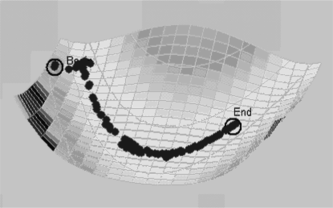
In this case, the equation is solved as a minimum search by the command fminsearch. The optimal minimum is at the point f(x) = 0, whereas xi always has to be unequal to zero. The calculation was done with the tool optimization as part of the mathematic software MathLab (The MathWorks Inc. Natrick, MA). To calculate the 7-dimensional problem, it was necessary to solve 200 equations within 123 iteration steps. All results were in the same range as the evolutionary algorithms.
As the second method, the “banana-function” (Equation (Equation3)) from Rosenbrock (Citation1960) as a common problem of minima was calculated with evolutionary algorithms to check their accuracy.
The known result of Equation (Equation3) is the minimum (1,1) with possible solutions between 0 an 100. All methods of the evolutionary algorithms showed an average deviation of 0.027% from the result of Nelder/Mead (Table ). Therefore 100 individuals and 1000 generation steps were used.
TABLE 4 Deviation of Results from Evolutionary Algorithms Compared with Results from the Banana-Function (Pollmann, Citation2007)
CONCLUSION
This research proved with different methods and inductive verification that it is possible to enhance the input of secondary materials for some paper types without any loss in quality. This enhanced input of secondary materials has economic as well as ecological impacts on the total paper production process. On the other hand, the research also showed that the use of evolutionary algorithms as part of artificial intelligence might have a role to play in waste management.
By posing a problem in a specific manner, the evolutionary algorithms can be applied to an array of other problems with an anthropogenic origin.
DECLARATION OF INTEREST
The described implementation of evolutionary algorithms and the application for the paper industry should show a possibility to reduce waste without any negative influence of quality. With this contribution, paper-producing companies have to rethink the production process itself to keep the paper production environmentally friendly. I herewith also certify that there is no actual or potential conflict of interest in relation to this article.
REFERENCES
- ATV-DVWK-Regelwerk. 2001 . Leaflet ATV-DVWK-M 364, Treatment, Recycling and Disposal of Production Specific Waste from Paper Production . Distribution : Community to support the waste water technique (GFA Gesellschaft zur Förderung der Abwassertechnik eV.). .
- Baccini , P. and H.-P. Bader . 1996. Regional Resource Management: Registration, Evaluation and Control . Heidelberg : Spektrum, Academic Publisher.
- Bos , J. H. , P. Veenstra , H. Verhoeven , and P. D. De Vos . 1999 . The Paper Book – Handbook of Paper Production . ECA Pulp & Paper . Houten , The Netherlands : EPN Publisher .
- BMU/Federal Ministry of Environment, Nature Protection and Reactor Safety . 2006 . Waster reduction and recycling strategies. Advancement of sustainable use or resources. Umwelt Nr. 3/2006 BGBI. I S. 1108.
- Erhard , K. 2006 . Fiber Property and Conditions for Fiber Usage . Presentation at the ZELLCHEMING Main Congregation, Contribution in: IPW, The Paper, 11-12/2006 .
- Gerdes , I. , F. Klawonn , and R. Kruse . 2004 . Evolutionary Algorithmns, Genetic Algorithmns – Strategies and Optimization Methods – Applications . Vieweg Publisher Wiesbaden .
- Gruber , E. 2000 . Chemical Technologies of Pulp and Paper . Manuscript of Lecture at the Technical University of Darmstadt for Students in Paper-Engineering .
- Leonhardt , W. 2000 . Control of Specific Paper Volume by Single Fiber Bending . Paper Technical Foundation PTS, Institute for Pulp and Paper, Contribution in: IPW, The Paper, 4/2000 .
- Meinl , G. 2007 . Dissertation for measuring and disposition of fiber length in different paper grades. (Unpublished Values) Information by Email.
- Meister , E. and V. Mediavilla . 1999 . Assessment of cultivation of launch of new fiber plants. Confederate Research Institute for Agro-Ecology and Cultivation, Project A 3.1. Colmar, France: Transbordery Institute for lucrative environmentally agriculture ITADA.
- Mondi Paper . 2007 . Measuring Results and Disposition of Fiber Length in Different Paper Grades . Mondi Paper, RSA .
- Pollmann , O. 2007 . Optimization Anthropogenic Material Streams for the Example of Paper . Dissertation, FB 13, TU Darmstadt, Institutional Series, WAR 189 .
- Pollmann , O. 2006 . Simulation of Anthropogenic Processes of Urban Metabolism . Biennial Conference and Exhibition “WasteCon 2006”; The Institute of Waste Management of South Africa (IWMSA), Cape Town, South Africa .
- PTS . 2007 . Dissertation for measuring and disposition of fiber length in different paper grades. (Unpublished Values) Information by Email from Mr. A. Manoiu.
- Rosenbrock , H. H. 1960 . An automatic method for finding the greatest or least value of a function . Oxford Journal 175 – 184 .
- Verband Deutscher Papierfabriken (VDP) . 2004 . Papier 2004 – Ein Leistungsbericht . Herausgeber : Verband Deutscher Papierfabriken e.V.